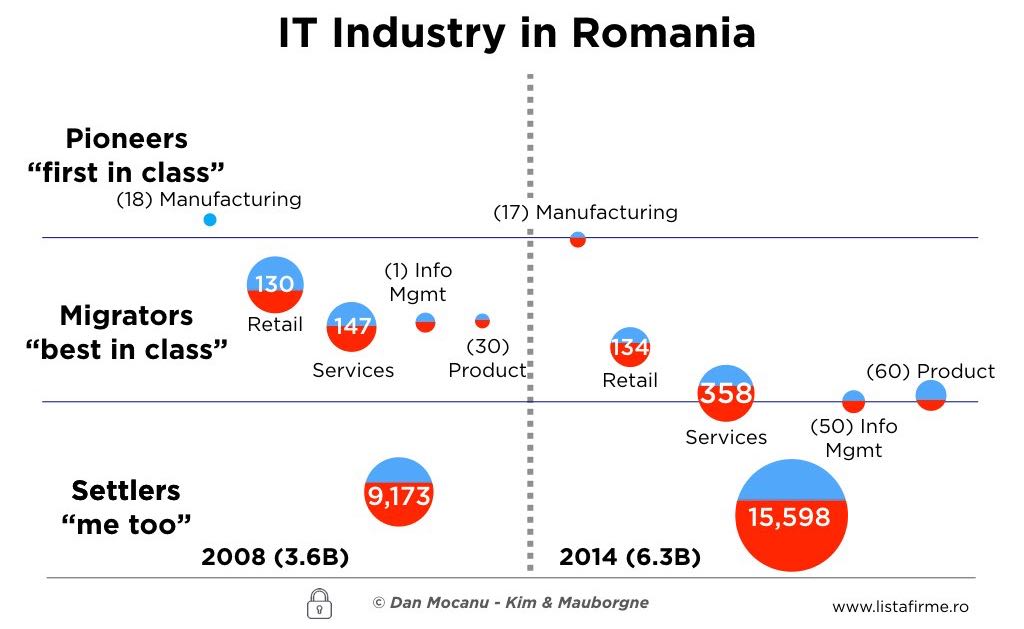IT is Romania’s darling, with revenue growth from 3.6 B in 2008 to 6.2B in 2014 and an evergreen demand for Romanian IT professionals. The IT tribe enjoys status, quality of life and optimistic projections … but just how optimistic should it be? Growth crowded the playfield. So, how blue is the IT ocean in Romania?
The answer comes through a couple of Blue Ocean Strategy tools developed by INSEAD’s Prof. Kim & Mauborgne. The analysis carves out the industry’s business growth and value innovation status.
Blue Ocean Strategy (BOS) is about creating new market spaces, where competition is irrelevant. It is both an “operating system” and an “SDK” to design “wow” value offerings for an ocean of buyers at a price they can afford AND at a low production cost. A BOS directs the energy and resources on what matters, eliminating and reducing everything else.
A BOS pattern of profitable growth shows that a small number of companies, under 14% of the total players, claim 38% or less in industry market share with 61% or more of the industry’s profits (i.e. iPhone: 20% market share, 90% of industry profit).
The Romanian IT playfield in 2014 has 16,255 players and 6 avenues of products and services: Software on Demand, Information Management Services, Product Development, Retail and Manufacturing.
Currently, no single company or group of companies display the Blue Ocean profitable growth pattern. The closest Blue Ocean trend was in Manufacturing in 2008 when 18 companies with turnover between 1-10Million Euro, had 35% of the total revenue of their sector and over 55% of the total sector profits. In 2014 the numbers erode with no companies going beyond 35% of total sector revenue and 35% of the total sector profit (i.e. 613 companies with turnover between €1-10 Million and 44 companies between €10-50 Million).
When applied, the Pioneer-Migrator-Settler Map reveals players’ performance from first-in-class (value innovators) to “me-toos” (commodities). Through this lens, we discover an industry with linear growth rates, shrinking profits and significantly more crowded trenches.
The value of the initial innovation is wearing out, and in the absence of a new wave of value innovation, a competition blood bath is in sight. The mushrooming number of companies in the lower revenue range points out that players are encouraged to enter the market, but with undifferentiated products and services, facing fierce competition.

The next Blue Ocean in IT is not going to come from innovation in technology per se. New Blue Oceans are tapped into through new utility that will demand new technologies.
The Apps & App store were not invented because of a breakthrough in technology but rather the technology had to be invented to give iPhone users an easy way to personalize their phones and create one place for developers to showcase and sell their apps.
Who will be the next pioneer in Romanian IT? The exploration begins in Iasi, July 15-16.
Map legend:
-
a number inside a disc (or between parentheses) = the number of firms contributing to the revenue and profit of that particular group of products or services: for example for the Retail group in 2008, the number 130 is the number of firms contributing to the revenue and profit of the group;
-
a disc / circle is the total revenue of a group of product or service; For example in 2008 the Retail Group in the Migrators section had 130 companies (brought in a revenue of 899 M Euro) representing 25% of the Total revenue of the IT Industry equal to 3.640B. The other group revenues where drawn to scale to represent their share of revenue from the whole;
-
the size of a circle grows with the square of a radius; if the revenue of a product or service has grown 4 times, then, the new radius is twice 2x the initial one; (Small growth is hardly observable on this kind of map). AirBnB grew 40 times from 100 M to 4B in 5 years. How many times larger is the radius of the new circle? (answer: sqrt (40) = 6.32)
-
the profit is shown in blue, as a percent from the group’s profit; for example for the Retail group in 2008, 130 firms brought in a total revenue of 899 M representing 49% of the group and 61% of the profit of the group.

